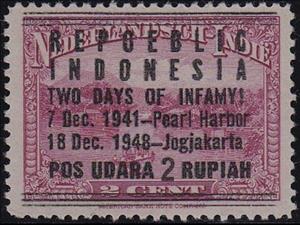Stamp: Barge on Java lake (Indonesia 1948)
Barge on Java lake (Indonesia 1948)
23 December (Indonesia ) within release Infamy overprint goes into circulation Stamp Barge on Java lake face value 2 Indonesian rupiah
| Stamp Barge on Java lake in catalogues | |
|---|---|
| Dai Nippon: | Dai: ID 100-11 |
Stamp is horizontal format.
The infamy overprints are comparable to the Vienna issues. Order was placed on 23 December 1948 and the stamps were valid through February 1950.Also in the issue Infamy overprint:
- Stamp - Barge on Java lake face value 2;
- Stamp - Barge on Java lake face value 2;
- Stamp - Buddhist stupas face value 7.50;
- Stamp - Dam and power station face value 2;
- Stamp - Dam and power station face value 2;
- Stamp - Dam and power station face value 2.50;
- Stamp - Lake Tondano (Celebes) face value 5;
- Stamp - Palm tree and Menangkabau house face value 2;
- Stamp - Palm tree and Menangkabau house face value 2.50;
- Stamp - Plane over Bromo Volcano face value 1;
- Stamp - Queen Wilhelmina face value 5;
- Stamp - Queen Wilhelmina face value 7.50;
- Stamp - Queen Wilhelmina face value 5;
- Stamp - Queen Wilhelmina face value 5;
- Stamp - Queen Wilhelmina face value 7.50;
- Stamp - Queen Wilhelmina face value 5;
- Stamp - Queen Wilhelmina face value 5;
- Stamp - Queen Wilhelmina face value 7.50;
- Stamp - Queen Wilhelmina face value 7.50;
- Stamp - Queen Wilhelmina face value 10;
- Stamp - Queen Wilhelmina face value 20;
- Stamp - Queen Wilhelmina face value 50;
- Stamp - Queen Wilhelmina face value 50;
- Stamp - Queen Wilhelmina face value 50;
- Stamp - Queen Wilhelmina face value 50;
- Stamp - Queen Wilhelmina face value 1;
- Stamp - Queen Wilhelmina face value 10;
- Stamp - Queen Wilhelmina face value 10;
- Stamp - Queen Wilhelmina face value 10;
- Stamp - Queen Wilhelmina face value 10;
- Stamp - Queen Wilhelmina face value 10;
- Stamp - Railway Viaduct Near Soekaboemi face value 1;
- Stamp - Railway Viaduct Near Soekaboemi face value 2;
- Stamp - Rice fields face value 1;
- Stamp - Rice fields face value 1;
- Stamp - University of medicine Batavia face value 1;
|
Data entry completed
86%
|
|
|---|---|
| Stamp Barge on Java lake in digits | |
| Country: | Indonesia |
| Date: | 1948-12-23 |
| Print: | Recess |
| Size: | 36 x 27 |
| Emission: | Air Post |
| Format: | Stamp |
| Face Value: | 2 Indonesian rupiah |
Stamp Barge on Java lake it reflects the thematic directions:
A lake is a naturally occurring, relatively large and fixed body of water on the Earth's surface. It is localized in a basin or interconnected basins surrounded by dry land. Lakes lie completely on land and are separate from the ocean, although they may be connected with the ocean by rivers, such as Lake Ontario. Most lakes are freshwater and account for almost all the world's surface freshwater, but some are salt lakes with salinities even higher than that of seawater. Lakes vary significantly in surface area and volume.
A landscape is the visible features of an area of land, its landforms and how they integrate with natural or man-made features. A landscape includes the physical elements of geophysically defined landforms such as (ice-capped) mountains, hills, water bodies such as rivers, lakes, ponds and the sea, living elements of land cover including indigenous vegetation, human elements including different forms of land use, buildings and structures, and transitory elements such as lighting and weather conditions. Combining both their physical origins and the cultural overlay of human presence, often created over millennia, landscapes reflect a living synthesis of people and place that is vital to local and national identity. The character of a landscape helps define the self-image of the people who inhabit it and a sense of place that differentiates one region from other regions. It is the dynamic backdrop to people’s lives. Landscape can be as varied as farmland, a landscape park, or wilderness. The earth has a vast range of landscapes, including the icy landscapes of polar regions, mountainous landscapes, vast arid desert landscapes, islands and coastal landscapes, densely forested or wooded landscapes including past boreal forests and tropical rainforests, and agricultural landscapes of temperate and tropical regions.
Rowing is the act of propelling a human-powered watercraft using the sweeping motions of oars to displace water and generate reactional propulsion. Rowing is functionally similar to paddling, but rowing requires oars to be mechanically attached to the boat, and the rower drives the oar like a lever, exerting force in the same direction as the boat's travel; while paddles are completely hand-held and have no attachment to the boat, and are driven like a cantilever, exerting force opposite to the intended direction of the boat.
A ship is a large watercraft that travels the world's oceans and other sufficiently deep waterways, carrying passengers or goods, or in support of specialized missions, such as defense, research and fishing. Historically, a "ship" was a sailing vessel with at least three square-rigged masts and a full bowsprit. Ships are generally distinguished from boats, based on size, shape and load capacity.




